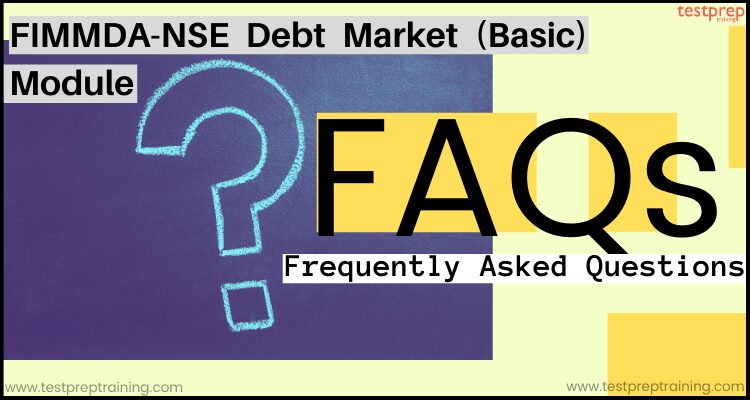FIMMDA-NSE Debt Market (Basic) Module: Exam FAQs

What is NSE?
NSE Academy Certification in Financial Markets, or NCFM, program is an online testing and certification program that tests the practical knowledge and skills required to operate in the financial markets. The NCFM program operates on our intranet and is administered through our designated test centers located across India.
What is FIMMDA-NSE Debt Market (Basic) Module?
FIMMDA-NSE Debt Market (Basic) Module helps in understanding the basic concepts of different types of debt instruments. This includes G-secs, T-bills, CPs, Bonds, and CDs. Further, this module provides:
- Firstly, useful insights into the Indian debt market and its various components
- Secondly, the trading mechanism of debt instruments in stock exchanges and bond valuation.
What knowledge enhancement will there is FIMMDA-NSE Debt Market (Basic) Module?
FIMMDA-NSE Debt Market (Basic) Module can help in gaining the knowledge and skills in various areas. This include:
- Firstly, this module will help to understand the fundamental features of debt instruments.
- Secondly, it includes concepts related to the trading of the debt instruments on the NSE-WDM Segment.
- Thirdly, this helps in understanding the regulatory and procedural aspects related to the debt market.
- Lastly, this module helps in learning the concepts of bond valuation, yield curve, bootstrapping, and duration.
Who is the target audience for FIMMDA-NSE Debt Market (Basic) Module?
For, FIMMDA-NSE Debt Market (Basic) Module, the best suitable audience include:
- Firstly, Students
- Secondly, Teachers
- Thirdly, Debt Market Dealers
- Then, Employees of BPO/IT Companies
- Lastly, individuals with interest in the Fixed Income Market
In how many languages NCFM exams are available?
NCFM exams are online and self-study exams that conducts across India that are available in the English language.
Is there any negative marking in the FIMMDA-NSE Debt Market (Basic) Module?
For the FIMMDA-NSE Debt Market (Basic) Module, Open Office Spreadsheet will be provided with an allowance for all types of calculators during the test. And, there will be a 0.25% negative marking for any incorrect answers.
How many questions will be there on FIMMDA-NSE Debt Market (Basic) Module?
There will be a total of 60 questions in the exam that has to be answered in a time duration of 120 minutes.
What is the passing score for FIMMDA-NSE Debt Market (Basic) Module?
To pass the exam it is necessary to score 60%. And, in the exam, there will be objective type questions only. That is, for every question, you will find four / five alternative answers.
How much the FIMMDA-NSE Debt Market (Basic) Module cost?
The exam will cost you Rs.2006/ inclusive of GST. And, the certification is valid for 5 years.
How to register for NCFM exam?
Candidates can register for the exam online by accessing the link ‘Online Registration’ available under Education then, click Certifications and Online Register / Enroll. After registration, you will receive a unique NCFM registration number along with a user id and password. Also, a confirmation will be sent to the email id and mobile number. After that, using the same, you can access your:
- Firstly, an online NCFM account to make payment
- Secondly, enroll for the test
- Thirdly, update the address
- Lastly, check study material status or viewing certificates
What is the course outline for the FIMMDA-NSE Debt Market (Basic) Module?
NCFM provides a course outline for the FIMMDA-NSE Debt Market (Basic) Module which will help you to understand the concepts in a sequential manner. They are:
- Firstly, Debt Instruments
- Secondly, Indian Debt Markets
- Thirdly, Central Government Securities: Bonds
- Then, State Government Bonds
- Next, Call Money Markets
- After that, Corporate Debt: Bond
- Commercial Paper & Certificate of Deposits
- Then, Repos
- After that, Bond Market Indices and Benchmarks
- Trading Mechanism in the NSE-WDM
- Lastly, Regulatory and Procedural Aspects
Is there any eligibility criteria for FIMMDA-NSE Debt Market (Basic) Module?
There is no eligibility criteria
What is the NCFM taking the test procedure?
- Firstly, candidates need to take the test at the designated NSE test center selected at the time of enrollment.
- Secondly, candidates need to be present at the test center 30 minutes prior to the test time. And, those reaching late will not have access to take the test. In such cases, the candidate would need to take the enrollment again.
- Thirdly, candidates need to carry an original Photo ID proof of verification. Valid photo ID proof includes PAN card, Driver’s License, Passport, Employee ID, Voter’s ID card, or Student ID card issued by college or school.
- Next, the candidate may bring a scientific calculator and a pen to the test venue. However, a backup sheet and rough sheet(s) would be provided to the candidates during the test.
What is the NCFM certificate issuing procedure?
NSE states that certificates for all modules will be given to the successful candidates at the test center itself. However, failed candidates will be provided with a scorecard at the test center. Candidates are requested to ensure that they collect the same before leaving the test center. Also, the successful candidates can view their certificates online under the link ‘Query/Report’ available in their NCFM online login.
How to upload photo for NCFM registration?
Candidates can upload photos online by accessing the link ‘Upload Photo’ available in their NCFM online login. Please note photo being uploaded should be:
- Passport size (3 X 3 cms or 1 X 1 inch or 150 X 180 pixels) (The photograph will be printed on your certificate. Hence, ensure that you upload appropriate passport size photograph only).
- in JPEG format.
- of file size below 30 KB

